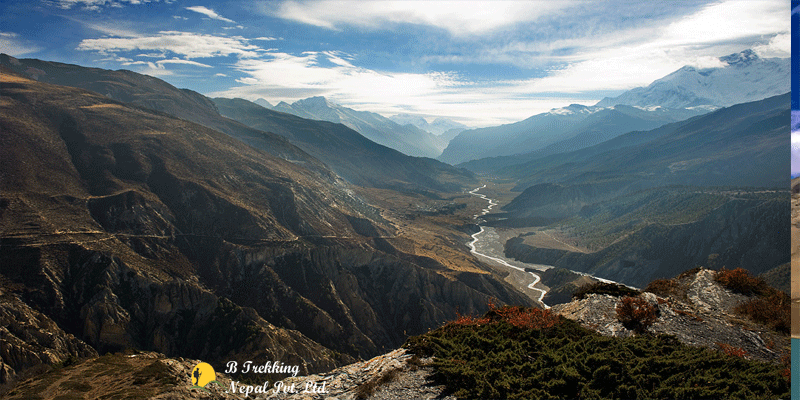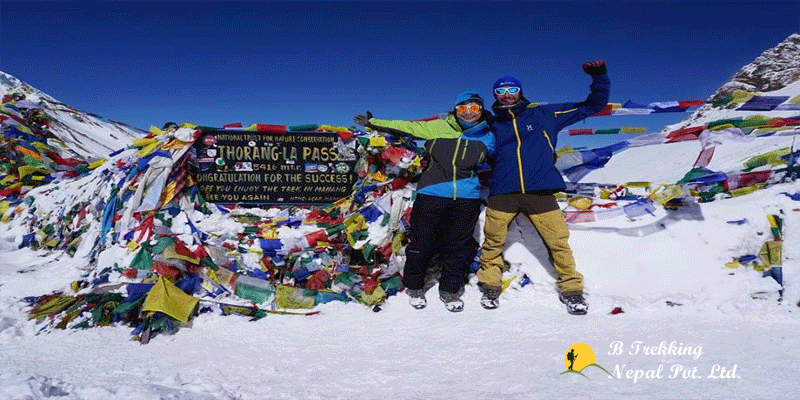 Feedback |
Feedback |
 Blog |
Blog |
 About |
About |
 Contact
Contact
![]()
![]()
![]() +977-9860313326
+977-9860313326
info@besttrekkinginnepal.com
Govt. Redg. no: 186992/074/075

Annapurna Circuit Trekking
Overview
The Annapurna Circuit Trek is a most popular trekking route of Nepal. It is a challenging but rewarding journey that takes you through diverse landscapes, ranging from subtropical forests to high-altitude deserts. The trek offers breathtaking views of the Annapurna and Dhaulagiri ranges, including some of the world's highest peaks such as Annapurna I, Manaslu, and Dhaulagiri. The average duration of the trek is 12-21 days, depending on your pace and itinerary.
The starting point of the trek is Besishahar, which is located about a 6-hour drive from Pokhara. From Besishahar, you follow the Marsyangdi River and enter the beautiful subtropical forests, where you can see waterfalls, bamboo groves, and local villages. The trail then gradually ascends through rice paddies, terraced fields, and traditional hamlets, where you can interact with the friendly local people and learn about their culture and lifestyle.
As you reach the higher elevations, the vegetation changes to scrub forests, and you get your first glimpses of the towering peaks of the Annapurna and Dhaulagiri ranges. The trail then becomes steeper and crosses Thorong La Pass (5,416 meters), which is the highest point of the trek. From Thorong La Pass, you have breathtaking views of the surrounding peaks, and can see the desert-like landscape of the Mustang region in the distance.
After crossing Thorong La Pass, you descend into the holy city of Muktinath, which is an important pilgrimage site for both Hindu and Buddhist communities. Muktinath is a fascinating place, with its sacred temples, natural hot springs, and vibrant local culture. From Muktinath, you continue your descent through the Kali Gandaki Gorge, which is one of the deepest gorges in the world, and is surrounded by towering peaks on both sides.
The final stretch of the trek takes you through the traditional villages and terraced fields of the lower Mustang region, where you can see the beautiful landscapes and local way of life. You pass through several small villages, cross several suspension bridges, and encounter local communities who are known for their hospitality and warmth. Finally, you reach the end of the trek at Jomsom, where you can catch a flight back to Pokhara.
The Annapurna Circuit Trek is a physically challenging journey, and requires a good level of fitness and preparation. However, it is a rewarding experience, and is highly recommended for anyone who loves adventure, nature, and mountain scenery. It is also an excellent opportunity to immerse yourself in the local culture and learn about the way of life in rural Nepal.
In conclusion, the Annapurna Circuit Trek is one of the most popular trekking routes in Nepal, and offers a unique opportunity to experience the natural beauty and cultural richness of the Himalayan region. With its stunning mountain views, diverse landscapes, and friendly local people, it is an unforgettable journey that will leave you with memories to last a lifetime.
Highlights of the Annapurna circuit Trek
Accommodation:- Hotel in cities /teahouse or camping in Trek
Grade:-Moderate
Best time to visit:- September to December / March to June
Culture: Gurung/Manage Bhote/Thakali/Magar
Elevation up to:- 5416m/ Thorong-la Pass
Trek start:-Jagat
Trek end:- Nayapul
Group size:- 1+
Details Itinerary
Day 01: Arrival in Kathmandu airport , we will meet you and transfer to Hotel , welcome dinner
Day 02: Trip briefing class and Trek preparing (Kathmandu city tour option)
Day 03: Drive from Kathmandu to Syange/ Jagat 8-10 hrs Driving
Day 04: Trek Jagat to Dharapani walking 5-6 hrs
Day 05: Dharapani to Chame walking 5-6 hrs
Day 06: Chame to Pisang walking 5-6 hrs
Day 07: Upper Pisang-Manang (3,500mt)walking 6-7 hrs
Day 08: Manang: Rest Day
Day 09: Manang-Yak Kharka walking 3-4 hrs
Day 10: Yak Kharka - Thorong Phediwalking 3-4 hrs
Day 11: Thorong Phedi – Muktinath walking 8-10 hrs
Day 12: Drive from Muktinath to Tatopani by local bus(private jeep option)
Day 13: Tatopani –Ghorepani walking 7-8 hrs
Day 14:Poon hill hike (3210m), and trek down to thikhedungha walking 6-7 hrs walk
Day 15:Trek to Nayapool and Drive to Pokhara 3-4 hrs walk and 1.5 hours driving
Day 16 joining in other trip or back to Kathmandu by drive ,6 hours ( flight option)
Day 17: Departure
Price Cover
Cost Includes:
- All Transportation: Your package includes all transportation.
- Hotel Accommodation with Breakfast: You'll have hotel stays in Kathmandu and Pokhara with breakfast included.
- Three Meals a Day During the Trek: Enjoy three meals a day (breakfast, lunch, and dinner) during your trek.
- Tea House Accommodation: Your accommodation during the trek will be in tea houses.
- Experienced Guide and Porters: You'll have the support of a government-licensed, experienced, helpful, and friendly guide and porters.
- Trekking Map and Trip Achievement Certificate: A trekking map to assist your journey and a trip achievement certificate upon completion.
- First Aid Medical Kit: Your guide will carry a first aid medical kit for any necessary medical attention.
- Annapurna Permits and TIMS Fee: The package covers the required permits and fees for the Annapurna region.
- Welcome and Farewell Dinner: You'll be part of a warm welcome and farewell dinner with fellow travelers.
- Government Taxes & Office Service Charge: All government taxes and service charges are included.
Cost Excludes:
- International Airfare: The cost of international flights to and from Kathmandu is not included.
- Nepal Entry Visa: You are responsible for obtaining and paying for your Nepal entry visa separately.
- Meals in Cities: Lunch and evening meals in cities are not included (except during the trek). This gives you the flexibility to explore the local cuisine.
- Extra Night Accommodation: Any additional night's stay in Kathmandu or Pokhara due to early arrival, late departure, or early return from the mountain is not included.
- Travel and Rescue Insurance: We recommend securing travel and rescue insurance for added safety during your adventure.
- Personal Expenses: Personal expenses such as phone calls, laundry, bar bills, battery recharge, extra porters, bottled or boiled water, and shower costs are not included.
- Tips: Tips for drivers, guides, and porters are not included and are given at your discretion.
FAQ
For the Annapurna Circuit trek, you will need a variety of equipment and clothing to ensure your comfort, safety, and enjoyment during the journey. Here's a detailed list of essential items to consider:
Footwear:
- Hiking Boots: Sturdy, waterproof hiking boots with good ankle support.
- Hiking Shoes: Lightweight and comfortable shoes for lower altitudes and easier terrain.
- Sandals: For resting your feet in tea houses or around the camp.
- Woolen Socks: To keep your feet warm and dry in colder conditions.
- Light Socks: For warmer days and lower altitudes.
Outwear:
- Tri-climate Jacket: A versatile 3-in-1 jacket suitable for various weather conditions.
- Down Jacket: A warm, insulated jacket for cold weather and high altitudes.
- Fleece Jacket: A mid-layer for added warmth during treks.
Clothing:
- Hats: A sun hat for protection from UV rays and a warm hat for colder weather.
- Gloves: Lightweight gloves for lower altitudes and warmer days, and thicker, insulated gloves for high altitudes.
- Hiking Pants: Lightweight and quick-drying pants for trekking.
- Cargo Pants: Additional pants for flexibility.
- Long Underwear Tops and Bottoms: For added warmth in colder conditions.
- Underwear: Moisture-wicking and comfortable underwear.
- Tee and Tank Tops: Breathable tops for lower altitudes.
Gear:
- Day Backpack: A small backpack to carry essentials during the day.
- Duffle Bag XL: To store your main trekking gear.
- Small Lock: For securing your bags.
- Sacks/Plastic Bags: For organizing and keeping your gear dry.
- Trekking Poles: Provides stability and reduces strain on your knees.
- Sleeping Bag: Suitable for cold temperatures.
- Trekking Towels: Lightweight and quick-drying towels for personal hygiene.
Accessories:
- Cameras, Batteries, and Memory Cards: To capture the stunning scenery.
- Sunglasses: To protect your eyes from UV rays and glare.
- Headlamp: A reliable light source for evenings and early mornings.
- Binoculars: For wildlife and scenic viewing.
- Tablet: Optional for entertainment or communication (consider the weight and charging options).
Personal & Medical:
- Water Bottle/Water Purification Tablets: To stay hydrated.
- Pain Relievers: For pain relief and altitude-related discomfort.
- Sun Block and Lip Balm: Protect your skin and lips from harsh sun and wind.
- Personal First Aid Kit: Basic medical supplies.
- Band-Aids: For minor cuts and blisters.
- Baby Wipes and Hand Wipes: For personal hygiene.
- Snacks and Goodies: Energy-boosting snacks.
- Plastic Ziplock Bags: For organizing and protecting items from moisture.
Keep in mind that specific equipment needs may vary based on the time of year, the chosen route, and weather conditions. It's important to consult with your tour operator and trekking guide to ensure you have the most suitable gear for your Annapurna Circuit trek.
Book this trip
Customize trip
| Category: Trekking |
| Duration: 17 Days |
| Average price: US$ 1500 only *per person |
| Views: 13099 |








